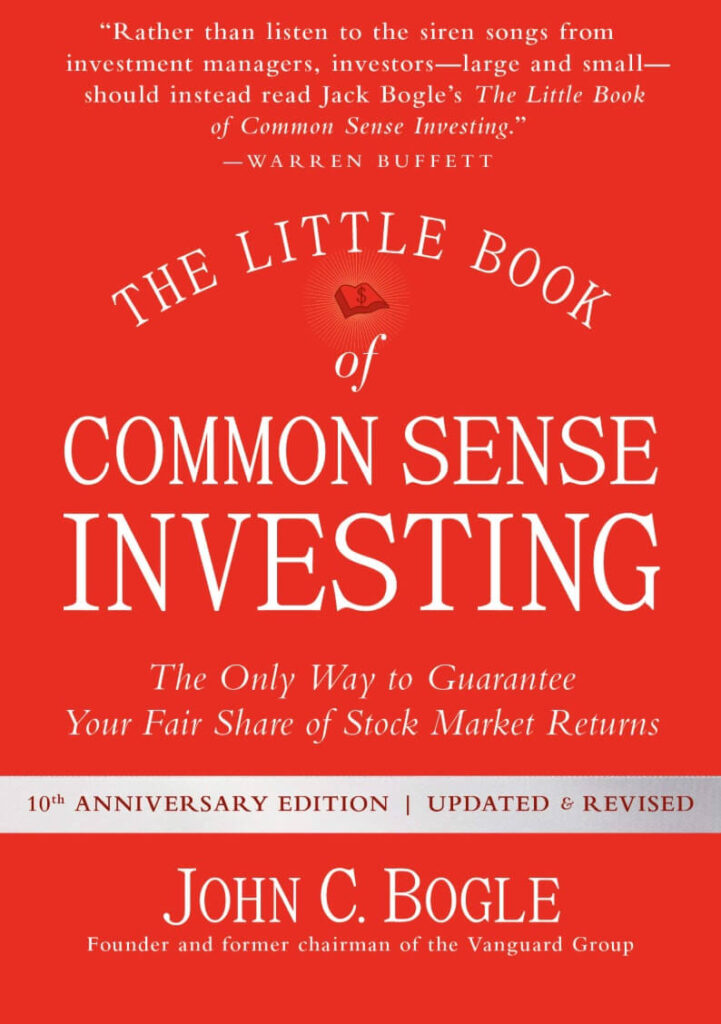The Only Way to Guarantee Your Fair Share of Stock Market Returns
🎯 Introduction: The Investing Classic with a Clear Mission
John C. Bogle’s The Little Book of Common Sense Investing is a landmark in personal finance literature — short, readable, and unapologetically focused on one central argument: most investors should invest in a low-cost, broad-market index fund and hold it for the long term.
The book is not about stock-picking, timing the market, or exotic strategies. Instead, it offers a simple but powerful investment philosophy rooted in logic, mathematics, and decades of empirical evidence. It has become a must-read for beginners and seasoned investors alike.
📜 Core Philosophy: Simplicity as Strength
At the heart of Bogle’s book is the Efficient Market Hypothesis (EMH), which holds that it is nearly impossible to consistently outperform the market because all known information is already reflected in stock prices. Bogle argues that active managers, who try to beat the market, are destined to underperform in aggregate once fees and costs are taken into account.
“Don’t look for the needle in the haystack. Just buy the haystack!”
— John C. Bogle
Instead of chasing alpha, Bogle urges investors to embrace the average — and in doing so, outperform the majority over the long term by avoiding the drag of high fees, taxes, and underperformance.
💰 The Index Fund Revolution
One of Bogle’s greatest contributions to the investment world was the creation of the first index mutual fund in 1976, under Vanguard. At the time, it was derided as “un-American.” Today, index funds dominate retirement accounts, robo-advisors, and passive portfolios.
The book explains in crisp terms how index funds work:
⦁ They buy and hold all (or most) of the stocks in a market index (like the S&P 500).
⦁ They are passively managed, so costs are very low.
⦁ They eliminate the need for forecasting, stock analysis, or market timing.
Bogle demonstrates with hard data that over 10, 20, and 30-year periods, index funds outperform the vast majority of actively managed mutual funds.
📉 Why Active Investing Fails Most People
Bogle does not mince words when critiquing Wall Street. He believes that most mutual funds are designed more to enrich fund managers than investors. Key reasons why active investing fails:
⦁ High fees: Actively managed funds often charge 1% or more annually, which compounds significantly over time.
⦁ Tax inefficiency: Frequent buying and selling leads to higher taxes for fund investors.
⦁ Short-termism: Many active funds chase quarterly performance, leading to poor long-term outcomes.
⦁ Luck vs. skill: Bogle presents compelling evidence that even the few funds that outperform in one period rarely continue to do so in the next.
The book reveals that over 90% of actively managed funds underperform their benchmark over long time horizons.
🧩 Investment Strategies Covered
While the book is relatively narrow in scope — focusing on one core idea — it does offer useful context and elaboration:
⦁ The Arithmetic of Investing: Bogle breaks down the math of net returns, showing how cost advantages compound.
⦁ Compounding vs. Churn: He explains how long-term holding allows compounding to work its magic, while high-turnover strategies erode it.
⦁ Diversification: Index funds offer instant diversification across sectors and companies, reducing single-stock risk.
⦁ Asset Allocation: While not a primary theme, Bogle briefly touches on the importance of balancing stocks and bonds based on age and risk tolerance.
🗣️ What Readers Love (Based on Positive Reviews)
✅ 1. Simplicity with Substance
Many readers praise the book for its clear, concise style. It takes complex ideas and boils them down to practical, actionable insights. There’s no financial jargon, no equations, no fluff — just solid advice, presented with conviction.
“It’s the one book I recommend to every new investor.”
— Common sentiment among financial bloggers and Reddit investors
✅ 2. Empirical Evidence
Bogle doesn’t rely on opinion alone — he backs up his claims with decades of data comparing active vs. passive performance. Charts and tables show how few active funds survive over the long term, let alone outperform.
✅ 3. Focus on Investor Protection
Bogle is clearly writing to help the small investor. His tone is paternal, almost moralistic, calling out the financial industry’s conflicts of interest and predatory behavior.
“He cared more about his investors than his own wealth. That makes this book feel like advice from a trusted mentor.”
— Amazon reviewer
🧨 Where It Falls Short (Based on Critical Reviews)
❌ 1. Repetition
A common critique is that the book is highly repetitive. Bogle circles back to the same themes — fees, index funds, simplicity — in nearly every chapter.
“It felt like reading the same chapter 12 times.”
— Goodreads review
While repetition can be pedagogical, some readers may find it tiresome, especially if they are already familiar with the concepts.
❌ 2. Limited Scope
The book focuses almost exclusively on U.S. equity index investing. There’s little discussion of:
⦁ International diversification
⦁ Real estate
⦁ Alternative investments
⦁ Behavioral finance
For readers seeking a comprehensive investing guide, the book may feel incomplete.
❌ 3. Lack of Practical Tools
Unlike other investment books (e.g., by Malkiel or Bernstein), Bogle does not provide sample portfolios, rebalancing strategies, or implementation tips. Readers looking for a step-by-step “how-to” may need supplemental material.
🔍 Deeper Analysis: Why This Book Still Matters
Even in a world dominated by ETFs, robo-advisors, and algorithmic trading, The Little Book of Common Sense Investing remains powerfully relevant.
🧠 A Psychological Anchor
In times of market turbulence, Bogle’s core message — “stay the course” — serves as an emotional ballast. The book doesn’t just offer an investing strategy; it offers a mindset: patience, humility, and consistency.
🌍 Democratizing Wealth
Bogle’s impact is not just academic or theoretical. The widespread adoption of index funds has saved American investors billions in fees. By advocating for simple, low-cost solutions, Bogle helped make investing accessible to ordinary people.
👣 The Legacy Lives On
The “Bogleheads” community, books like The Bogleheads’ Guide to Investing, and platforms like Vanguard and Wealthfront all carry forward the ideas planted in this little book. Its influence is vast — and growing.
⭐ Final Verdict: ★★★★★ (5/5)
The Little Book of Common Sense Investing is an essential read for anyone who wants to invest wisely, avoid Wall Street’s traps, and build long-term wealth. While its narrow focus and repetitive delivery may turn off some readers, its core message — supported by decades of research and a legendary career — is undeniably sound.
Who Should Read It:
⦁ First-time investors
⦁ Passive investing advocates
⦁ Anyone skeptical of high-fee funds or stock-picking advice
⦁ Long-term, buy-and-hold investors




